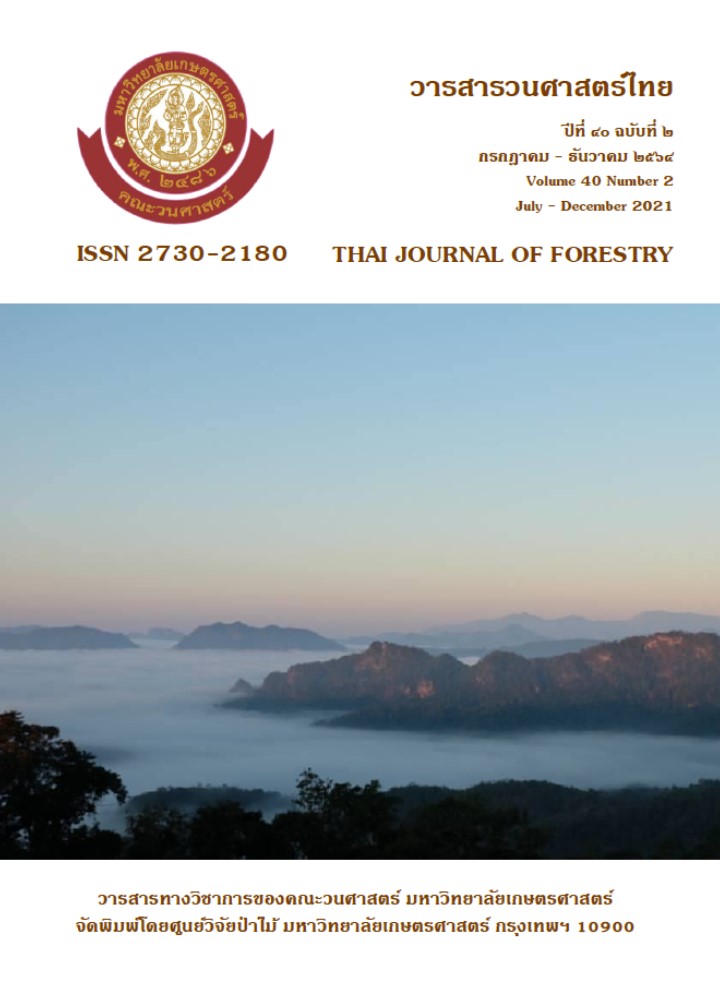ผลของวัสดุปลูกและอุณหภูมิในการเก็บรักษาสปอร์เห็ดเผาะหนัง (Astraeus odoratus) ต่อการเติบโตและการเกิดรากเอคโตไมคอร์ไรซา ของกล้าไม้ยางนา (Dipterocarpus alatus)
Main Article Content
บทคัดย่อ
การศึกษาครั้งนี้มีวัตถุประสงค์เพื่อศึกษาผลของวัสดุปลูกและอุณหภูมิต่อการเก็บรักษาสปอร์เห็ดเผาะหนัง และความสามารถต่อการเติบโตและการเกิดรากเอคโตไมคอร์ไรซาของกล้าไม้ยางนา โดยทำการทดสอบวัสดุปลูก 2 สูตร คือ สูตรที่ 1 เวอร์มิคิวไลต์ + พีตมอสส์ (8:2) และ สูตรที่ 2 ดิน + แกลบดำ + ขุยมะพร้าว (1:1:1) ผลการศึกษาพบว่ากล้าไม้ที่ปลูกในวัสดุปลูกสูตรที่ 1 มีอัตราการเกิดรากเอคโตไมคอร์ไรซา 42.09 เปอร์เซ็นต์ และมีการเติบโตสัมพัทธ์ทางด้านความสูงมากกว่ากล้าไม้ที่ปลูกเชื้อด้วยวัสดุปลูกสูตรที่ 2 ที่ไม่มีการเกิดรากเอคโตไมคอร์ไรซา สำหรับการทดสอบผลของอุณหภูมิในการเก็บรักษาสปอร์เห็ดเผาะหนังเป็นเวลานาน 2 ปี ด้วยอุณหภูมิที่ต่างกัน 3 ระดับ ได้แก่ อุณหภูมิห้อง 4 องศาเซลเซียส และ -20 องศาเซลเซียสในการปลูกเชื้อ ผลการศึกษาพบว่าสปอร์เห็ดเผาะหนังที่เก็บรักษาไว้นาน 2 ปี สามารถทำให้กล้าไม้เกิดรากเอคโตไมคอร์ไรซาได้ โดยอุณหภูมิที่เหมาะสมในการเก็บรักษาสปอร์เห็ดเผาะหนัง คือ -20 องศาเซลเซียส ซึ่งพบว่ากล้าไม้ที่ปลูกเชื้อด้วยสปอร์ที่เก็บรักษาที่อุณหภูมิ -20 องศาเซลเซียส ส่งผลให้มีอัตราการเกิดรากเอคโตไมคอร์ไรซาสูงกว่า (61.04 เปอร์เซ็นต์) กล้าไม้ที่ปลูกเชื้อด้วยสปอร์ที่เก็บรักษาไว้ที่อุณหภูมิห้อง (22.51 เปอร์เซ็นต์)
Downloads
Article Details

อนุญาตภายใต้เงื่อนไข Creative Commons Attribution-NonCommercial-NoDerivatives 4.0 International License.
ข้าพเจ้าและผู้เขียนร่วม (ถ้ามี) ขอรับรองว่า ต้นฉบับที่เสนอมานี้ยังไม่เคยได้รับการตีพิมพ์และไม่ได้อยู่ในระหว่างกระบวนการพิจารณาตีพิมพ์ลงในวารสารหรือสิ่งตีพิมพ์อื่นใด ข้าพเจ้าและผู้เขียนร่วม (ถ้ามี) ยอมรับหลักเกณฑ์และเงื่อนไขการพิจารณาต้นฉบับ ทั้งยินยอมให้กองบรรณาธิการมีสิทธิ์พิจารณาและตรวจแก้ต้นฉบับได้ตามที่เห็นสมควร พร้อมนี้ขอมอบลิขสิทธิ์ผลงานที่ได้รับการตีพิมพ์ให้แก่วารสารวนศาสตร์ คณะวนศาสตร์ มหาวิทยาลัยเกษตรศาสตร์ กรณีมีการฟ้องร้องเรื่องการละเมิดลิขสิทธิ์เกี่ยวกับภาพ กราฟ ข้อความส่วนใดส่วนหนึ่ง หรือ ข้อคิดเห็นที่ปรากฏในผลงาน ให้เป็นความรับผิดชอบของข้าพเจ้าและผู้เขียนร่วม (ถ้ามี) แต่เพียงฝ่ายเดียว และหากข้าพเจ้าและผู้เขียนร่วม (ถ้ามี) ประสงค์ถอนบทความในระหว่างกระบวนการพิจารณาของทางวารสาร ข้าพเจ้าและผู้เขียนร่วม (ถ้ามี) ยินดีรับผิดชอบค่าใช้จ่ายทั้งหมดที่เกิดขึ้นในกระบวนการพิจารณาบทความนั้น”
เอกสารอ้างอิง
Beltrano, J., M. Ruscitti, M.C. Arango and M. Ronco. 2013. Effects of arbuscular mycorrhiza inoculation on plant growth, biological and physiological parameters and mineral nutrition in pepper grown under different salinity and p levels. J. Soil Sci. Plant Nutr. 13(1): 123-141.
Brundrett, M.C., N. Bougher, B. Dell, T. Grove and N. Malajczuk. 1996. Working with Mycorrhizas in Forestry and Agriculture. ACIAR Monograph 32. Pirie Printers, Canberra.
Chalermpongse, A. and T. Boonthavikoon. 1981. The Investigation of Mycorrhizal Fungi Associated with Roots of Trees in Sakaerat Dry-Dipterocarp Forest Ecosystem. Forest pest control branch, Royal Forest Department, Bangkok.
Chalermpongse, A. and T. Boonthavikoon. 1982. The Investigation of Ectomycorrhiza in Dry-Evergreen Forest Ecosystem. Forest pest control branch, Royal Forest Department, Bangkok.
Clausing, S., L.E. Likulunga, D. Janz, H.Y. Feng, D. Schneider, R. Daniel, J. Krüger, F. Lang and A. Polle. 2020. Impact of nitrogen and phosphorus addition on resident soil and root mycobiomes in beech forests. bioRxiv (unpublished preprints): https://doi.org/10.1101/ 2020.12.29.424645.
Corbery, Y. and F.L. Tacon. 1997. Storage of ectomycorrhizal fungi by freezing. Ann. sci. for. (online) 54(2): 211-217.
Dokmai, P., C. Phosri, R. Khangrang and N. Suwannasai. 2015. Above- and below-ground ectomycorrhizal diversity in a pine-oak forest in northeastern Thailand. Chiang Mai J. Sci. 42(1): 80-88
Duangkae, K. 2002. Mycorrhiza: diversity and development, pp. 187-252. In Proceedings of Biodiversity of Forest Resources and Wildlife “Progress Report and Activities in 2005”. August 22-28, 2002. Department of National Parks, Wildlife and Plant Conservation, Bangkok. (in Thai)
Ishida, T.C., K. Nara, M. Tanaka, A. Kinoshita and T. Hogetsu. 2008. Germination and infectivity of ectomycorrhizal fungal spores in relation to their ecological traits during primary succession. New Phytol. 180(2): 491–500.
Juge, C., J. Samson, C. Bastien, H. Vierheilig, A. Coughlan and Y. Piché. 2002. Breaking dormancy in spores of the arbuscular mycorrhizal fungus Glomus intraradices: a critical cold-storage period. Mycorrhiza 12: 37–42.
Kaewgrajang, T., U. Sangwanit, K. Iwase, M. Kodama and M. Yamato. 2013. Effects of ectomycorrhizal fungus Astraeus odoratus on Dipterocarpus alatus seedlings. J. Trop. For. Sci. 25(2): 200–205.
Kaewgrajang, T., B. Sakolrak, U. Sangwanit and J. Wongprom. 2015. Growth responses of Shorea roxburghii G. Don seedlings associated with Astraeus odoratus ectomycorrhizal mushroom, pp. 66-69. In Forest Research: Forest Annual Conference 2015. April 22-26, 2015. Faculty of Forestry Kasetsart University, Bangkok. (in Thai)
Klintong, W. 2010. Effects of Astraeus spp. Mycelial Inocula on Mycorrhizal Formation and Growth Simulation of Dipterocarpus alatus Roxb. ex G. Don Seedlings. M.S. Thesis, Chulalongkorn University. (in Thai)
Lin, C., Y. Wang, M. Liu, Q. Li, W. Xiao and X. Song. 2020. Effects of nitrogen deposition and phosphorus addition on arbuscular mycorrhizal fungi of Chinese fir (Cunninghamia lanceolata). Sci. Rep. 10: 12260.
Lu, X. and R.T. Koide. 1994. The effects of mycorrhizal infection on components of plant growth and reproduction. New Phytol. 128: 211–218.
Nara, K. 2009. Spore of ectomycorrhizal fungi: ecological strategies for germination and dormancy. New Phytol. 181: 245-248.
Phosri, C., R. Watling, M.P. Martin and A.J.S. Whalley. 2004. The genus Astraeus in Thailand. Mycotaxon 89: 453–463.
Phosri, C., R. Watling, N. Suwannasa, A. Wilson and M.P. Martin. 2014. A new representative of star-shaped fungi: Astraeus sirindhorniae sp. nov. from Thailand. PLoS One 9(5): e71160. doi:10.1371/journal.pone.0071160.
Poomipan, P., S. Sammayo and P. Reunsuk. 2020. Effect of available phosphorus in soil on efficiency of Arbuscular mycorrhizal fungi, Glomus intraradices. Thai Science and Technology Journal 28(2): 294-307.
Sangtiean, T. and U. Sangwanit. 1994. Growth of Dipterocarpus alatus Roxb. seedlings inoculated with ectomycorrhizal fungi. J. For 13: 22-28. (in Thai)
Sangwanit, U., P. Suwannarit, A. Payappanon, J. Luangsaard, A. Chandrasrikul and B. Sakolrak. 2013. List of Mushrooms. Biodiversity-Based Economy Development Office (Public Organization), Bangkok. (in Thai)
Smith, S.E. and D. Read. 2010. Mycorrhizal Symbiosis. Academic Press, New York.
Suwannarach, N., J. Kumla and S. Lumyong. 2015. A new whitish truffle, Tuber thailandicum from northern Thailand and its ectomycorrhizal association. Mycol. Prog. 14(10): 83
Youpensuk, S. 2006. Mycorrhiza. Department of Biology, Faculty of Science, Chiang Mai University, Chiang Mai. (in Thai)
Yuwa-Amornpitak, T., T. Vichitsoonthonkul, M., Tanticharoen, S. Cheevadhanarak and S. Ratchadawong. 2006. Diversity
of ectomycorrhizal fungi on Dipterocarpaceae in Thailand. J. Biol. Sci. 6(6): 1059-1064


